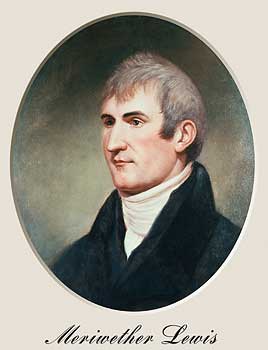Undaunted Courage, by Stephen E. Ambrose (Simon & Schuster, 374pp.) is not just the book title, but the words used by Jefferson to describe Lewis. The book is exhaustively researched, fascinating, and brings Jefferson, Lewis, Clark, and Sacagawea to life as you‘ve most likely never known them before. It is not only a great read, but well worth adding to your permanent library.
Meriwether Lewis was charged with a lot more than exploring the river and drawing a map of the newly purchased Louisiana Territory, the Western United States. He studied celestial navigation so he could plot the latitude and longitude of every Missouri River bend, rapids, island, junctions of the Missouri with other rivers or feeder streams. He had to maintain a journal in triplicate, hand writing each separately, in the event one should be lost. Two copies were done on paper and wrapped in oil cloth, and one was done on birch bark. He had to report back to Jefferson as often as possible and by whatever means, like a trapper going down stream to St. Louis with his furs. Every Indian tribe he met had to be studied, have a workable dictionary made of every tribal dialect, list their location, their populations, what diseases they had, and what remedies they used, the age at which their women began and ended menstruation, the age of marriage, how long they nursed their children, samplings of their normal pulse rates morning, noon, evening, and before and after eating, their food, what time they rose, their normal daily routine, how often they bathed, all manner of housing and clothing, their knowledge of, and what he could find of, the presence of dinosaur bones and volcanoes, their social tendencies toward murder and suicide, what they employed besides alcohol for intoxication, their religious beliefs and ceremonies, how they disposed of their dead, their social tendencies and relations with other tribes, what they might need and what they could offer in the way of trade, their movements or migrations, study what would be needed for America to take over the U. S. fur trade currently dominated by the English and French, and where trading posts could be established. He studied taxidermy and needed to collect and catalog specimens of every form of flora and fauna previously unknown to them, and send back as many preserved specimens as possible, along with drawings, measurements and descriptions. He had to study the potential for farming with inspection and assessment of different soils and their fertility, assess what factors may influence farming practices, monthly and annual rainfall, and temperature ranges and daily measurements. The northern boundary of Louisiana Territory was described as the latitude of the northern-most tributary of any stream feeding into the Missouri River. What streams they couldn’t personally investigate had to be documented by multiple independent statements obtained from Indians and trappers that had ventured into those regions. This was important for a boundary line to be established between the new American and British territories.
He had met William Clark when they served together in the Army. Anyone involved in business or relationships will tell you that a partnership is the most fragile organizational form, and the one most likely to fail. Yet, with all the ego that goes with military command, they worked perfectly together for years. Thomas Jefferson could think of no one he had more confidence in than Lewis, and Lewis felt the same about Clark. Specifically to avoid the conflicts of a joint command, Secretary of War Dearborn ignored Lewis’ request that he and Clark have the same rank, same pay, and be recognized jointly as leaders of the expedition. Dearborn made Lewis commander with the rank of captain, and Clark his subordinate with a rank and pay of lieutenant. In history, Lewis won. Neither is recognized by most people unless their names are said together, like the first and last name of one person, ‘Lewis N. Clark‘.
Much of what Lewis discovered was previously totally unknown to science. In the end, the journals of the expedition filled eight printed volumes. Collected specimens are found in several museums. Meeting the expectations of Jefferson, the scientific community of the Enlightenment, and a public wanting to migrate west, while at the same time meeting the demands of moving an expedition into unknown territory against the current of an often wild river, among unpredictable Indian nations, fighting starvation and meeting ten-foot deep snows in the passes is a mind-boggling accomplishment. Yet, Lewis ended by committing suicide because he felt he hadn’t done enough. When there was a crisis, any emergency, when the odds against succeeding were virtually impossible to surmount, Lewis was the man anyone would want in command. However, when the crisis was past and he had time to sit idle, he would immediately slip into manic depression, begin drinking, and start relying on the drugs he needed to fight the malaria contracted on the expedition, and which would plague him the balance of his life. In spite of all he accomplished, he still felt lacking and defensive about not attaining perfection. He felt such imperfections would serve as an embarrassment to Jefferson, and it became more than he could handle.
Credit: 2 portraits by Google pictures


No comments:
Post a Comment